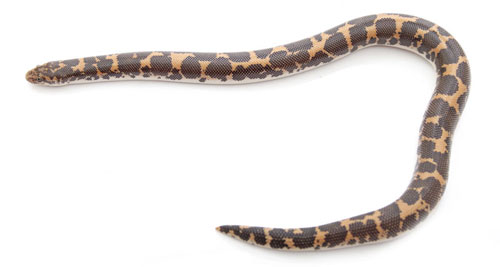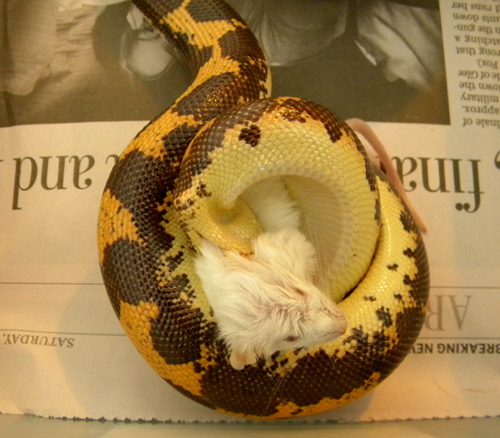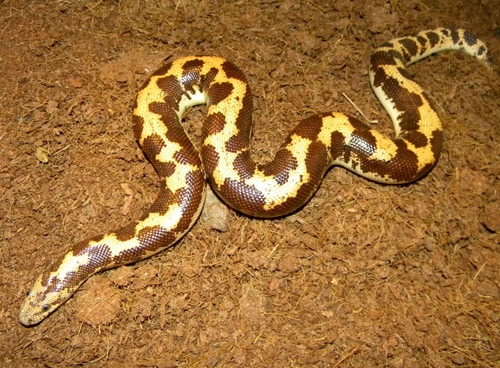Care sheet for the Kenyan sand boa (Eryx colubrinus).
Kenyan Sand Boa (Eryx colubrinus)
The Kenyan sand boa has a dedicated and growing following due to its manageable size, passive personality and simple captive care requirements. If you prioritize reptile health and wellness, quality husbandry, and using proper snake supplies, this could be the snake for you! The Kenyan sand boa is also referred to as the “East African sand boa,” although hobbyists have largely adopted “Kenyan” for the common name.
Kenyan Sand Boa Availability
Captive-bred Kenyan sand boas are usually easy to locate. Reptile breeders, pet stores, and online reptile stores are good sources to find Kenyan sand boas. The naturally occurring color of Kenyan sand boas is beautiful as it is, but there are also plenty of color morphs to choose from. Some of the available morphs for Kenyan sand boas include albino, anerythristic, snow, paradox, striped, tiger and others.
Kenyan Sand Boa Size
The Kenyan sand boa is a small boa, with females reaching little more than 2 feet in length. Male Kenyan sand boas tend to be smaller than females, rarely exceeding 20 inches in length. Kenyan sand boas have a heavy, stout body.

Kenyan sand boas can live 20 years and longer. Photo Credit: Gina Cioli/i5 Studio
How Long Does The Kenyan Sand Boa Live?
Although the captive requirements for the Kenyan sand boa are nominal, they can require a long-term commitment, as there are reports of Kenyan sand boas exceeding 30 years in captivity. I have two female Kenyan sand boas in my collection that have been with me for almost 20 years, and they were both at least 2 years old when I acquired them. As of this writing, one of them is still actively breeding, but her production has slowed down in the past few years, and I plan to retire her from the breeding program.
Kenyan Sand Boa Enclosure
The Kenyan sand boa is appealing to many keepers because of its minimal space requirements. Even the largest female Kenyan sand boa can be comfortably housed in a 10-gallon reptile terrarium with a secure lid, or a similarly sized enclosure. A plastic storage container of appropriate dimensions, along with air holes, will also work well in a heated shelving unit. The shelves must be tightly fitted with little room above the top of the individual container, because Kenyan sand boas can easily push the lid off of a plastic container. For reptile terrariums, you can use Zilla cage clips and locks to prevent escape.
If a terrarium with a screen lid is used for the Kenyan sand boa, I advise using an undertank heating pad under one side of the cage (like the Zilla heat mat), left on 24/7, along with an incandescent overhead lamp fixture during the day, to heat the air in the cage. The hotspot under the light should be approximately 95 degrees Fahrenheit and the cooler side of the enclosure should be around 80 degrees. A drop to the mid-70s at night is acceptable. This can be measured using reptile thermometers.
I have kept Kenyan sand boas communally, with no issues whatsoever, but separating them for feeding is always recommended. I have only done this with one male and one female, or two females. Male Kenyan sand boas should not be housed together.
Given the Kenyan sand boa’s propensity for burrowing, habitat accessories should be minimal. Heavy rocks should be avoided, unless they are firmly fastened to the enclosure. If a Kenyan sand boa burrows beneath heavy rocks and causes a mini-avalanche, the result could be injury or even death to the snake. Despite its small size, the Kenyan sand boa can be very destructive to your cage’s interior design, so décor does not need to be excessive.
Decorative branches can be a nice touch, but they are not necessary. In my 20-plus years of working with Kenyan sand boas, I don’t ever remember seeing a Kenyan sand boa even attempt to climb. Kenyan sand boas are terrestrial creatures that prefer to spend most of their time underground.
Kenyan Sand Boa Substrate
Many people naturally assume the only choice of substrate for the Kenyan sand boa is sand. The truth is the Kenyan sand boa can be kept on a variety of reptile beddings, including aspen bedding, coconut mulch, play sand and even newspaper. I have kept and bred Kenyan sand boas on all of these materials . I do recommend staying away from gravel, corncob bedding and, for all reptiles, cedar shavings.
What Do Kenyan Sand Boas Eat For Food?
The Kenyan sand boa has a strong appetite for live reptile food, specifically mice. Baby Kenyan sand boas typically prefer live pinky mice to get started, but with maturity, they almost always switch to frozen/thawed prey. Even with dead food, the prey is usually constricted. I use 12-inch metal tweezers to offer thawed mice to my snakes.
Adult male Kenyan sand boas will accept a large hopper mouse, and an adult female Kenyan sand boa can handle a jumbo-sized mouse. Males tend to eat less frequently than females, although there are always exceptions. Some of my males will eat every chance they get.
I offer food to the female Kenyan sand boas every week and to the males every 10 to 14 days. Kenyan sand boas that are shedding will often strike and constrict their meal, but then abandon it. For this reason, I do not offer food to Kenyan sand boas during their shed cycle.

Female Kenyan sand boas can eat a jumbo sized mouse once a week. Males eat large hopper mice every 10 to 14 days. Photos © TheReptileRainforest.com
Kenyan Sand Boa Water
A sturdy ceramic bowl, like the Petrageous dish, is a good choice as a water dish for a Kenyan sand boa. A light plastic water dish will be easily pushed over, possibly fouling the environment. The only time the cage should have high humidity is during the Kenyan sand boa’s shed cycle. High humidity is important during the shed cycle to ensure all of the skin comes off safely. A humid hide box is rarely utilized, so I prefer to use a good old-fashioned spray bottle. It’s also a lot easier to increase the humidity in a plastic bin than it is in an open-air environment, such as a terrarium with a screen lid. You can measure the humidity with reptile hygrometers.
Kenyan Sand Boa Handling and Temperament
Most of the Kenyan sand boas I have worked with have been even-tempered. A few Kenyan sand boa specimens I have encountered were feistier than normal, though they tried to squirm away rather than actually bite. Not being mindful of the speedy feeding response of the Kenyan sand boa is one way to land an accidental bite. Pick a Kenyan sand boa up from the middle of its body, giving the snake a chance to realize that it’s not dinnertime. If you approach a Kenyan sand boa from above, near the front third of its body, it may assume you are food and strike at you. A bite from a Kenyan sand boa is no more severe than a scratch from a housecat, to put it into perspective, but it can still be painful for you and traumatic for the snake, and for these reasons a bite should be avoided.
Darren Boyd is a professional musician, herpetoculturist, and all-around troublemaker. His reptile breeding and education-based business, The Reptile Rainforest, has been operating since 1995. www.TheReptileRainforest.com



